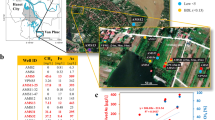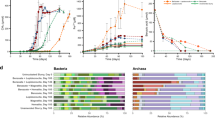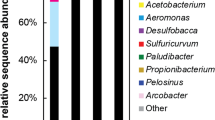Abstract
THE contamination of sub-surface water supplies with aromatic compounds is a significant environmental concern1,2. As these contaminated sub-surface environments are generally anaerobic, the microbial oxidation of aromatic compounds coupled to nitrate reduction, sulphate reduction and methane production has been studied intensively1–7. In addition, geochemical evidence suggests that Fe(III) can be an important electron acceptor for the oxidation of aromatic compounds in anaerobic groundwater. Until now, only abiological mechanisms for the oxidation of aromatic compounds with Fe(III) have been reported8–12. Here we show that in aquatic sediments, microbial activity is necessary for the oxidation of model aromatic compounds coupled to Fe(III) reduction. Furthermore, a pure culture of the Fe(III)-reducing bacterium GS-15 can obtain energy for growth by oxidizing benzoate, toluene, phenol or p-cresol with Fe(III) as the sole electron acceptor. These results extend the known physiological capabilities of Fe(III)-reducing organisms and provide the first example of an organism of any type which can oxidize an aromatic hydrocarbon anaerobically.
This is a preview of subscription content, access via your institution
Access options
Subscribe to this journal
Receive 51 print issues and online access
$199.00 per year
only $3.90 per issue
Buy this article
- Purchase on Springer Link
- Instant access to full article PDF
Prices may be subject to local taxes which are calculated during checkout
Similar content being viewed by others
References
Berry, D. F., Francis, A. J. & Bollag, J.-M. Microbiol. Rev. 51, 43–59 (1987).
Wilson, B. H., Smith, B. G. & Rees, J. F. Environ. Sci. Technol. 20, 997–1002 (1986).
Young, L. Y. & Frazer, A. C. Geomicrobiol. J. 5, 261–293 (1987).
Suflita, J. M., Gibson, S. A. & Beeman, R. E. J. ind Microbiol. 3, 179–194 (1988).
Kuhn, E. P., Zeyer, J., Eicher, P. & Schwarzenbach, R. P. Appl. environ. Microbiol. 54, 490–496 (1988).
Vogel, T. M. & Gribic-Galic, D. Appl. environ. Microbiol. 53, 254–260 (1988).
Major, D. W., Mayfield, C. I. & Barker, J. F. Ground Water 26, 8–14 (1988).
Stone, A. T., in Geochemical Processes at Mineral Surfaces (eds Davis, J. A. & Hayes, K. F.) 446–461 (Am. Chem. Soc. Symp. Series 323, 1986).
Stone, A. T. & Morgan, J. J., in Aquatic Surface Chemistry (ed. Stumm, W.) 221–254 (Wiley, New York, 1987).
Lakind, J. S. & Stone, A. T. Eos 69, 369 (1988).
Lehmann, R. G., Cheng, H. H. & Harsh, J. B. Soil Sci. Soc. Am. J. 51, 352–356 (1987).
McBride, M. B. Soil Sci. Soc. Am. J. 51, 1466–1472 (1987).
Van Breeman, N. in Iron in Soils and Clay Minerals, NATO ASI Series C (eds Stucki, J. W. et al.) 797–823 (Reidel, Boston, 1988).
Ponnamperuma, F. N. Adv. Agron. 24, 29–96 (1972).
Baedecker, M. J. & Back, W. J. Hydrol. 43, 393–414 (1979).
Champ, D. R., Gulens, J. & Jackson, R. E. Can. J. Earth Sci. 16, 12–23 (1979).
Hult, M. F. in U.S. Geological Survey Water Resources Investigations Report 84-4188 (ed. Hult, M. F.) 1–15 (U.S. Geological Survey, 1984).
Eganhouse, R. P., Dorsey, T. F., Phinney, C. S., Baedecker, M. J. & Cozzarelli, I. M. Geological Society of American Annual Meeting Abstracts 19, 652 (1987).
Cozzarelli, I. M., Eganhouse, R. P. & Baedecker, M. J. in U.S. Geological Survey Water Resources Investigation Report 88-4220 (eds Mallard, G. E. & Ragone, S. E.) (U.S. Geological Survey, in the press).
Phillips, E. J. P. & Lovley, D. R. Soil Sci. Soc. Am. J. 51, 938–941 (1987).
Lovley, D. R. & Phillips, E. J. P. Appl. environ. Microbiol. 53, 2636–2641 (1987).
Lovley, D. R. & Goodwin, S. Geochim. cosmochim. Acta 52, 2993–3003 (1988).
Baedecker, M. J., Siegel, D. I., Bennett, P. C. & Cozzarelli, I. M. in U.S. Geological Survey Water Resources Investigation Report 88–4220 (eds Mallard, G. E. & Ragone, S. E.) (U.S. Geological Survey, in the press).
Lovley, D. R. & Phillips, E. J. P. Appl. Environ. Microbiol. 52, 751–757 (1986).
Ghiorse, W. C. in Biology of Anaerobic Microorganisms (ed. Zehnder, A. J. B.) 305–331 (Wiley, New York, 1988).
Lovley, D. R. Geomicrobiol. J. 5, 261–293 (1987).
Lovley, D. R., Stolz, J. F., Nord Jr, G. L. & Phillips, E. J. P. Nature 330, 252–254 (1987).
Lovley, D. R. & Phillips, E. J. P. Appl. environ. Microbiol. 54, 1472–1480 (1988).
Myers, C. R. & Nealson, K. H. Science 240, 1319–1321 (1988).
Lovley, D. R., Phillips, E. J. P. & Lonergan, D. J. Appl. environ. Microbiol. 55, 700–706 (1989).
Author information
Authors and Affiliations
Rights and permissions
About this article
Cite this article
Lovley, D., Baedecker, M., Lonergan, D. et al. Oxidation of aromatic contaminants coupled to microbial iron reduction. Nature 339, 297–300 (1989). https://doi.org/10.1038/339297a0
Received:
Accepted:
Issue Date:
DOI: https://doi.org/10.1038/339297a0
This article is cited by
-
Magnetic susceptibility as a proxy for detection of total petroleum hydrocarbons in contaminated wetlands
Environmental Monitoring and Assessment (2023)
-
Electromicrobiology: the ecophysiology of phylogenetically diverse electroactive microorganisms
Nature Reviews Microbiology (2022)
-
Microbial production of toluene in oxygen minimum zone waters in the Humboldt Current System off Chile
Scientific Reports (2022)
-
Prospect of utilizing coal mine drainage sludge as an iron source for value-creating applications
Reviews in Environmental Science and Bio/Technology (2021)
-
Inactivation of Escherichia coli enhanced by anaerobic microbial iron reduction
Environmental Science and Pollution Research (2021)
Comments
By submitting a comment you agree to abide by our Terms and Community Guidelines. If you find something abusive or that does not comply with our terms or guidelines please flag it as inappropriate.



